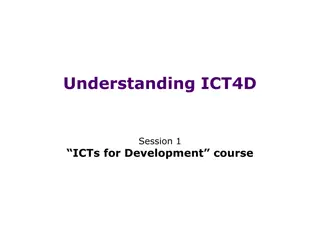
Data Analysis in Medical Sciences and Environmental Studies
Explore the goals and objectives of data analysis, understand different types of data, delve into steps for analysis, and interpret quantitative data in the context of medical sciences and environmental studies. Learn about common descriptive statistics, measures of central tendency, and distribution curves to enhance your analytical skills.
Download Presentation

Please find below an Image/Link to download the presentation.
The content on the website is provided AS IS for your information and personal use only. It may not be sold, licensed, or shared on other websites without obtaining consent from the author. If you encounter any issues during the download, it is possible that the publisher has removed the file from their server.
You are allowed to download the files provided on this website for personal or commercial use, subject to the condition that they are used lawfully. All files are the property of their respective owners.
The content on the website is provided AS IS for your information and personal use only. It may not be sold, licensed, or shared on other websites without obtaining consent from the author.
E N D
Presentation Transcript
UNIVERSITY OF NIGERIA, NSUKKA COLLEGE OF POSTGRADUATE STUDIES ICT/Data Analysis in Medical Sciences/Environmental Studies Prof Emmanuel N. Aguwa Institute of Public Health Email: emmanuel.aguwa@unn.edu.ng Phone: 08034873064
GOALS AND OBJECTIVES Define & Identify types of data Analyze different types of data Common descriptive statistics Common tests of significance Tests of Association Understand basic concepts in Excel, SPSS and EPI INFO
INTRODUCTION What are data? Facts or information used to analyze, or plan something. Types of data: 1. QUALITATIVE DATA is a categorical measurement expressed by means of a natural language description Nominal Categories: e.g. are gender, race, religion, or sport. Ordinal Variables: may be ordered e.g. small, medium, large 2. QUANTITATIVE DATA is a numerical measurement. Quantitative can be Discrete or Continuous
Steps in Data Analysis Before data Collection After data Collection Determine the method of data analysis Determine how to process the data Consult a Statistician Prepare dummy tables Process the data Prepare tables and graphs Analyze and interpret findings Consult again the statistician Prepare for editing
Analyzing and Interpreting Quantitative Data Descriptive statistics e.g. Frequencies Cross-tabulations Test of significance Chi Square, Student t-test Test of Association - Correlation -Regression
The value of r ranges between ( -1) and ( +1) The value of r denotes the strength of the association as illustrated by the following diagram strong intermediate weak weak intermediate strong -1 -0.75 -0.25 0.25 0.75 0 1 indirect Direct perfect correlation perfect correlation no relation
Regression Equation SBP(mmHg) 220 Regression equation describes the regression line mathematically 200 180 160 140 120 100 80 120Wt (kg) 60 70 80 90 100 110 y = a + bx Where a = intercept on y axis b = slope
Serial no. Age (x) Weight (y) 1 2 3 4 5 6 7 6 8 5 6 9 12 8 12 10 11 13
Analyzing and Interpreting Qualitative Data Qualitative data is thick in detail and description. Data often in a narrative format Data often collected by observation, open-ended interviewing, document review Analysis often emphasizes understanding phenomena as they exist, not following pre-determined hypotheses
Types of Qualitative Analysis Content analysis Narrative analysis Discourse analysis Framework analysis Grounded theory
Analyzing qualitative data Content analysis steps: 1. Transcribe data (if audio taped) 2. Read transcripts 3. Highlight quotes and note why important 4. Code quotes according to margin notes 5. Sort quotes into coded groups (themes) 6. Interpret patterns in quotes 7. Describe these patterns
Practical Sessions Introduction to Excel, Epi Info and SPSS
Thank You for Listening Thank You for Listening
Recommended Materials SPSS Step-by-Step: http://www.datastep.com/SPSSTutorial_1.pdf A Handbook of Statistical Analysis using SPSS by Sabine Landau and Brian S. Everitt: http://www.academia.dk/BiologiskAntropologi/Epidemiologi/PDF/SP SS_Statistical_Analyses_using_SPSS.pdf https://www.coursera.org/learn/data-analysis-tools Offered free by Wesleyan University Connecticut, USA (enrolment starts today 3rd September)






















